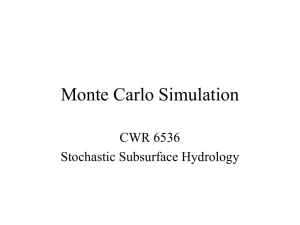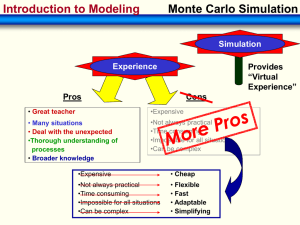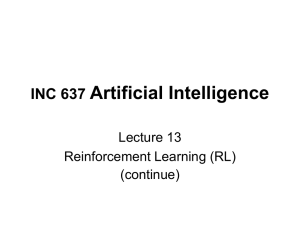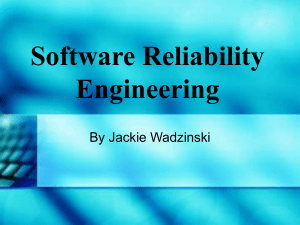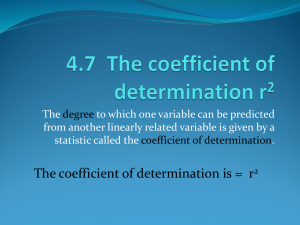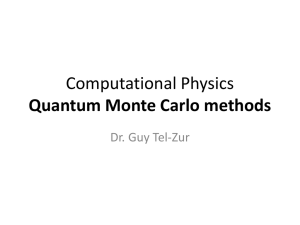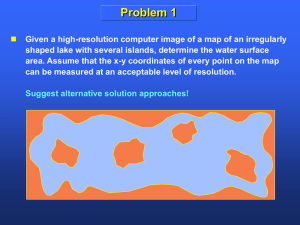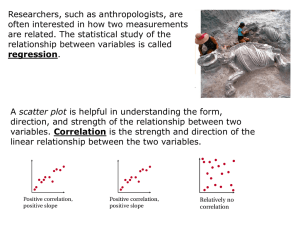Monte Carlo Simulation
advertisement
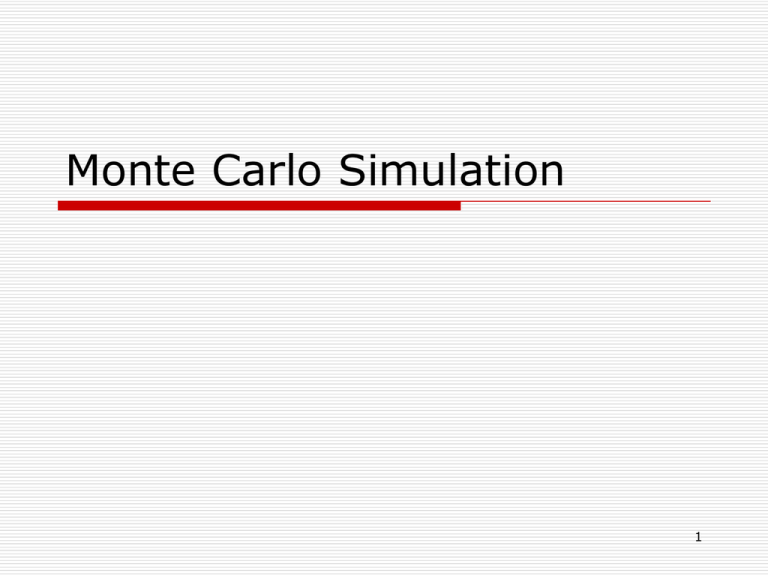
Monte Carlo Simulation 1 Monte Carlo Simulation Simulations where random values are used but the explicit passage of time is not modeled Static simulation Introduction Simulation of the maximum value when rolling two fair die 2 Monte Carlo Simulation IE 425 – Function optimization Simulated annealing Genetic algorithms IE 415/515 Engineering economic analysis Probability models Integration Project network simulation 3 Monte Carlo Simulation Lab 1 – use Monte Carlo simulation to estimate the true confidence level of confidence intervals. 4 History Developed by Manhattan Project scientists near the end of WWII. Monte Carlo, Monaco has been associated with casino gambling, which is based on randomization procedures and games of chance. Since the new simulation techniques relied on randomization procedures it was given the name “Monte Carlo” simulation. 5 Monte Carlo Simulation Inputs to an “analysis” are unpredictable Outputs of the analysis are 6 Monte Carlo Simulation How do we represent unpredictability? 7 Monte Carlo Simulation Diagram 8 Assumptions Assume that we have methods for generating observations from different probability distributions. How this is accomplished will be covered later. 9 Summarizing/Characterizing Risk in Engineering Economic Calculations Much of the cash flow data used in engineering economic analysis are “best estimates”. In reality, we do not know what the actual cash flows will be. 10 Terminology Risk – Uncertainty – 11 Quick Review of NPV NPV – Net Present Value Applicable to a series of cash flows over time. Computes the value of all cash flows today (the present). We will only consider years as time periods with given annual interest rates. 12 Quick Review of NPV 13 Quick Review of NPV 14 Quick Review of NPV 15 In-Class Exercise Two alternative heating systems are being considered, gas and electric, for a temporary building to be used for 5 years. The gas system will cost $6K to install (at year 0). It is estimated that this system will have a salvage value of $500 after 5 years, and will have annual fuel and maintenance costs of $1K. The electric system will cost $8K to install and has an estimated 5 year salvage value of $1.5K. The estimated annual fuel and maintenance costs are $750 per year. The assumed MARR (interest rate) = 6%. 16 17 18 Example Should you purchase a service contract with a new vehicle? Your plan is to keep the vehicle for 8 years. The service contract begins after the warranty expires (5 yrs.) and it lasts for 5 years. It covers the same items as the manufacturers warranty. The cost is $750 at the time of purchase and it is transferable when the vehicle is 19 sold. Example What cash flows do you need to consider? Why only these cash flows? 20 Example Analysis using best estimates of cash flow. $5K No Contract 0 1 2 3 4 5 6 7 8 $150 $700 $5.5K With Contract 0 $750 1 2 3 4 5 6 7 8 Best estimate MARR (Interest) = 5% 21 Example 22 Example What do we know and don’t know with certainty? Known Unknown 23 Addressing Risk Using Monte Carlo Simulation Basic Approach No approach can eliminate risk/uncertainty. 24 Addressing Risk Using Monte Carlo Simulation Replace best estimates with probability distributions. Generate an observation from each distribution and perform the engineering economic calculation – repeat. The answer is now in the form of a histogram. 25 Implementation What is required to make implementation practical? 26 MS Excel Capability Data Tab Data Analysis → Random Number Generation Requires Analysis ToolPak installation 27 Simulation Demonstration Excel Year 6 maintenance cost Uniform( ) Year 7 maintenance cost Uniform( ) Salvage Value Normal( ) 28 Simulation Demonstration Excel Crystal Ball Automates/expands the capabilities within Excel to conduct Monte Carlo simulations 29 In-Class Discussion Generate ideas for making this simulation “better” (more realistic). 30 Independent Random Variables Two random variables X and Y are independent if PX ,Y ( X x , Y y ) PX ( X x ) * PY (Y y ) F X ,Y ( x , y ) F X ( x ) * FY ( y ) Continuous random variables f X ,Y ( x , y ) f X ( x ) * f Y ( y ) Discrete random variables p X ,Y ( X x , Y y ) p X ( X x ) * p Y ( Y y ) 31 Independent Random Variables Properties of simple functions of independent random variables X and Y, (which are also random variables). E ( X * Y ) E ( X ) * E (Y ) 32 Dependent Random Variables Properties of simple functions of dependent random variables X and Y. 33 Correlations Between Variables Covariance CovXY is a measure of the linear dependence between two random variables Cov X ,Y E ( X * Y ) E ( X ) * E (Y ) CovXY can be positive or negative. Since CovXY is not dimensionless, it’s magnitude is relative. Correlation is “normalized” covariance. 1 XY Cov XY X Y 2 1 2 34 Estimates of Correlation Pearson’s correlation coefficient n r 1 n 1 ( xi x )( y i y ) i 1 s X sY A measure of the linear relationship in observed data (𝑥𝑖 , 𝑦𝑖 ). MS Excel function CORREL(…) 35 Estimates of Correlation Pearson’s correlation coefficient Can determine statistical significance of the correlation if (𝑋𝑖 , 𝑌𝑖 ) has a bivariate normal distribution tr N 2 1 r 2 which is distribute d approximat ely as a t distributi on with N- 2 degrees of freedom. 36 Estimates of Correlation Rank correlation – Spearman’s rank-order correlation coefficient. Estimates of Correlation Estimating rank correlation – Spearman’s rank-order correlation coefficient estimated from data. Pearson’s correlation coefficient estimate applied to the ranks. n rS 1 n 1 ( Ri R )( S i S ) i 1 sR sS where R i is the rank of x i and S i is the rank of y i . Estimates of Correlation Another formula for an estimate N D (R i Si ) 2 i 1 D Sum of the squared difference in ranks. With no ties in the ranks of the X or Y then rS 1 6D N N 3 Example Pearson's Correlation Coefficient -0.007218 i 1 2 3 4 5 6 7 8 9 10 11 12 13 14 15 16 17 18 19 20 21 22 23 24 25 X 4.399536 2.444634 5.488515 7.552947 7.3967 8.466266 0.632825 4.531638 7.190045 2.826599 3.619592 1.619135 1.306178 3.044741 3.452986 0.764138 3.86415 4.191905 5.269706 4.269014 4.346019 4.259519 7.685283 4.829431 4.627685 Spearman's Rank-Order Correlation Coefficient -0.020312 Y Rank X Rank Y 9.967498 24 1 7.696615 42 24 5.944395 16 46 6.07242 8 42 6.041749 9 43 7.668233 5 25 7.900632 50 22 5.224921 23 49 6.616718 10 36 7.559893 41 29 6.237678 36 40 7.59331 46 27 8.124332 48 20 9.94293 40 2 5.138859 38 50 7.436903 49 31 9.859462 34 3 8.214515 31 19 8.0665 17 21 5.905026 28 48 6.267586 26 39 7.859279 29 23 9.605243 7 8 8.630177 21 14 9.78988 22 6 Last 25 rows not shown Di2 529 324 900 1156 1156 400 784 676 676 144 16 361 784 1444 144 324 961 144 16 400 169 36 1 49 256 In-class Exercise Compute Spearman’s rank-order correlation coefficient for the following paired X,Y observations. i 1 2 3 4 5 6 7 8 9 10 X 34 46 1 27 39 11 38 30 17 8 Y 26 16 -26 -1 13 6 25 2 -12 -1 Estimates of Correlation The test of a non-zero rS uses the test statistic t rS N 2 1 rS 2 which is distribute d approximat ely as a t distributi on with N- 2 degrees of freedom. In-class Exercise Test whether the rS value computed in the last in-class exercise is significantly different from zero at alpha=0.05 (t8,0.025= 2.31). Extended Warranty Example Crystal Ball simulates correlation using rank correlation. Demo 44
